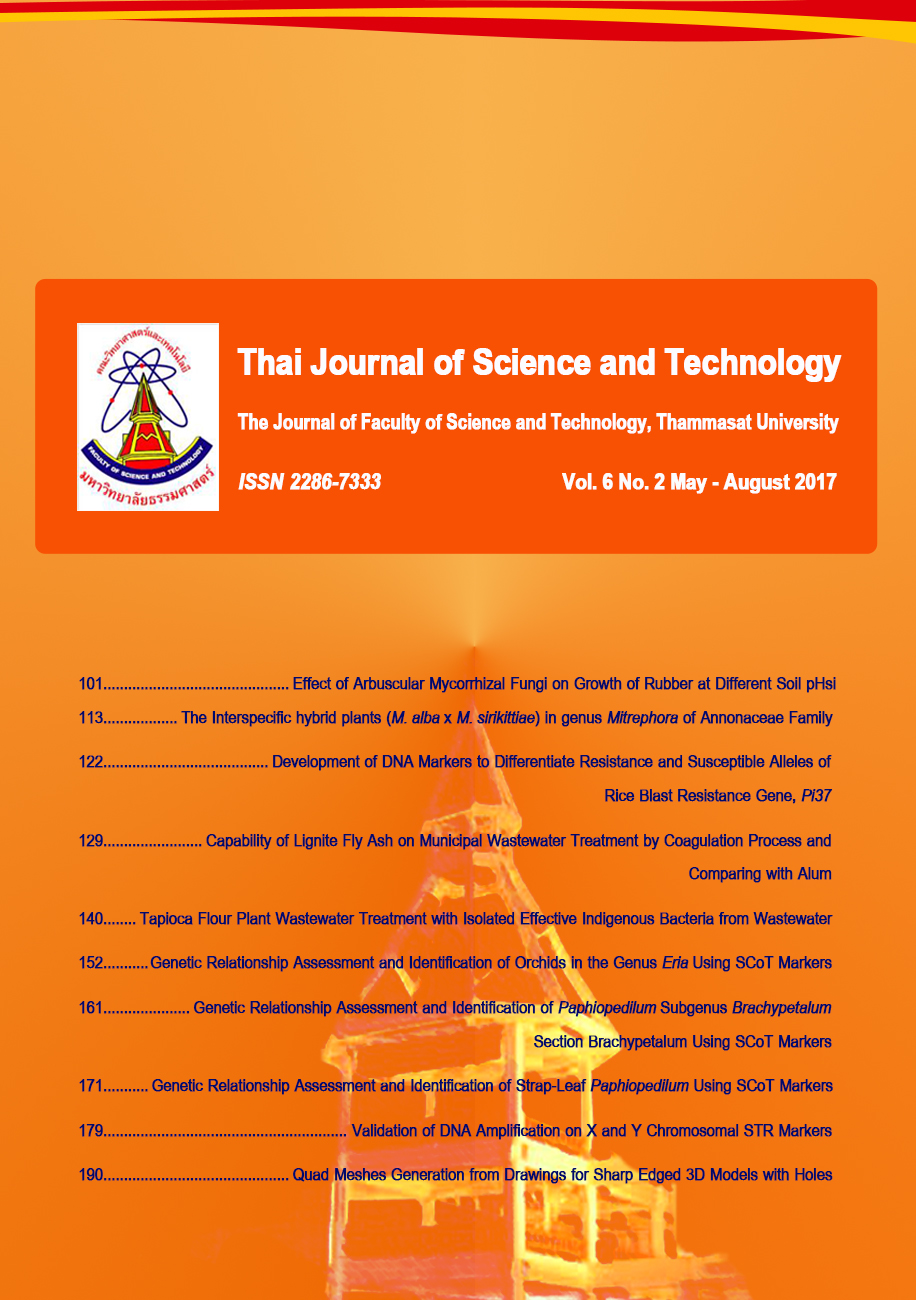ความสามารถของเถ้าลอยลิกไนต์ต่อการบำบัดน้ำเสียชุมชนด้วยกระบวนการสร้างตะกอนและเปรียบเทียบกับสารส้ม
Main Article Content
Abstract
บทคัดย่อ
งานวิจัยนี้เป็นการศึกษาการนำเถ้าลอยลิกไนต์ 3 ชนิด คือ ชนิด FA1, FA2 และ FA3 เป็นสารสร้างตะกอนต่อการบำบัดน้ำเสียชุมชน เปรียบเทียบกับสารละลาย Al2(SO4)3 (10.0 มิลลิกรัมต่อมิลลิลิตร) และสารส้มน้ำทางการค้า (6.6 % w/w Al2O3) ทดลองแบบจาร์เทสต์ โดยศึกษาปริมาณสารสร้างตะกอน pH ของน้ำเสีย และระยะเวลาในการตกตะกอน ปริมาณสารสร้างตะกอนทั้ง 5 ชนิด ที่เหมาะสมต่อน้ำเสียชุมชน 1 ลิตร คือ 1.5, 1.0 และ 0.5 กรัม สำหรับ FA1, FA2 และ FA3 ตามลำดับ 10.0 และ 2.0 มิลลิลิตร สำหรับสารละลาย Al2(SO4)3 และสารส้มน้ำ ตามลำดับ นอกจากนี้พีเอชของน้ำเสียเท่ากับ 7 สำหรับ FA1 และสารส้มน้ำ และเท่ากับ 6 สำหรับ FA1, FA2 และสารละลาย Al2(SO4) ระยะเวลาในการตกตะกอน 4 วัน สำหรับ FA1 และ FA2 3 วัน สำหรับ FA3 และสารละลาย Al2(SO4)3 และ 2 วัน สำหรับสารส้มน้ำ สารสร้างตะกอนทั้ง 5 ชนิด มีประสิทธิภาพในการกำจัดความขุ่นสูงถึงร้อยละ 99 และเถ้าลอยลิกไนต์ทั้ง 3 ชนิด ให้ประสิทธิภาพที่ดีใกล้เคียงกับสารละลาย Al2(SO4)3 และสารส้มน้ำ อย่างไรก็ตาม เถ้าลอยลิกไนต์ชนิด FA3 ให้ประสิทธิภาพดีกว่าชนิด FA1 และ FA2 เนื่องจากมีองค์ประกอบของโลหะออกไซด์สูงจึงสามารถทำลายเสถียรภาพของคอลลอยด์ในน้ำเสียได้ นอกจากนี้ได้ศึกษากับน้ำเสียชุมชน 20 ลิตร โดยใช้สารสร้างตะกอน 5 ชนิด ที่สภาวะที่เหมาะสม และวิเคราะห์พารามิเตอร์ของคุณภาพน้ำทั้งก่อนและหลังผ่านการสร้างตะกอน 9 พารามิเตอร์ พบว่าเถ้าลอยลิกไนต์ชนิด FA3 มีประสิทธิภาพในการบำบัดทุกพารามิเตอร์ได้สูง คือ บำบัดความขุ่น บีโอดี ซีโอดี ปริมาณของแข็งทั้งหมด ปริมาณไนโตรเจนทั้งหมด แอมโมเนียไนโตรเจน ปริมาณฟอสฟอรัสทั้งหมด ออร์โธฟอสเฟต และน้ำมันและไขมันได้ร้อยละ 99.39, 98.18, 85.71, 81.28, 52.67, 49.35, 76.52, 82.24 76.30 ตามลำดับ
คำสำคัญ : สารสร้างตะกอน; เถ้าลอยลิกไนต์; น้ำเสียชุมชน
Abstract
This research investigated the use of three types of lignite fly ashes, namely FA1, FA2 and FA3, as coagulant on municipal wastewater treatment, compared with Al2(SO4)3 solution (10.0 mg/mL) and commercial liquid alum (6.6 % w/w Al2O3). In jar test experiment, dosage of coagulant, pH of wastewater and settling time were carried out. The appropriated dosages of 5 coagulants per 1 L of community wastewater were 1.5, 1.0 and 0.5 g for FA1, FA2 and FA3, respectively and 10.0 and 2.0 mL for Al2(SO4)3 solution and liquid alum, respectively. Moreover, pH of wastewater at 7.0 for FA1 and liquid alum, and pH of wastewater at 6 for FA1, FA2 and Al2(SO4)3 solution. Settling time at 4 days for FA1 and FA2, at 3 days for FA3 and Al2(SO4)3 solution and at 2 days for liquid alum. 5 Types of coagulants at these conditions showed the removal efficiency of high turbidity up to 99 % while 3 types of FA gave the good efficiency, comparable to those of ASS and CLA. Nevertheless, FA3 gave a better efficiency than those of FA1 and FA2. This might be related to high content of metal oxide component that could destroy colloidal stability in the wastewater. In addition, the 20 liters of wastewater were tested by using 5 coagulants at suitable condition and analyzed for 9 water quality parameters of wastewater, in conditions of before and after pass through coagulation. The results revealed that FA3 gave the highest treatment for all of parameters; with turbidity removal, BOD, COD, TS, TKN, NH3-N, total-P, ortho-P and FOG at 99.39, 98.18, 85.71, 81.28, 52.67, 49.35, 76.52, 82.24 and 76.30 %, respectively.
Keywords: coagulant; lignite fly ash; municipal wastewater
Article Details
บทความที่ได้รับการตีพิมพ์เป็นลิขสิทธิ์ของคณะวิทยาศาสตร์และเทคโนโลยี มหาวิทยาลัยธรรมศาสตร์ ข้อความที่ปรากฏในแต่ละเรื่องของวารสารเล่มนี้เป็นเพียงความเห็นส่วนตัวของผู้เขียน ไม่มีความเกี่ยวข้องกับคณะวิทยาศาสตร์และเทคโนโลยี หรือคณาจารย์ท่านอื่นในมหาวิทยาลัยธรรมศาสตร์ ผู้เขียนต้องยืนยันว่าความรับผิดชอบต่อทุกข้อความที่นำเสนอไว้ในบทความของตน หากมีข้อผิดพลาดหรือความไม่ถูกต้องใด ๆ


